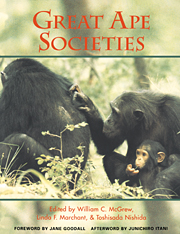Book contents
- Frontmatter
- Contents
- List of contributors
- Preface
- Foreword: conserving great apes
- Part I Apes overviewed
- Part II Social ecology
- Part III Social relations
- Part IV Minds
- 12 Conflict as negotiation
- 13 Language perceived: Paniscus branches out
- 14 Reciprocation in apes: from complex cognition to self-structuring
- 15 Chimpanzee intelligence in nature and in captivity: isomorphism of symbol use and tool use
- Part V Apes compared
- Part VI Modeling ourselves
- Afterword: a new milestone in great ape research
- Appendix: great ape study sites
- Index
13 - Language perceived: Paniscus branches out
Published online by Cambridge University Press: 04 August 2010
- Frontmatter
- Contents
- List of contributors
- Preface
- Foreword: conserving great apes
- Part I Apes overviewed
- Part II Social ecology
- Part III Social relations
- Part IV Minds
- 12 Conflict as negotiation
- 13 Language perceived: Paniscus branches out
- 14 Reciprocation in apes: from complex cognition to self-structuring
- 15 Chimpanzee intelligence in nature and in captivity: isomorphism of symbol use and tool use
- Part V Apes compared
- Part VI Modeling ourselves
- Afterword: a new milestone in great ape research
- Appendix: great ape study sites
- Index
Summary
LANGUAGE AS THE DOMAIN OF HOMO
Human beings have traditionally viewed their capacity for language as something special and unique amongst the creatures of the planet. The communication systems of all other animals have been described as ‘non-verbal,’ a term implying the absence of intentionality, symbolic encoding and internal structure (Hinde, 1972; Feldman & Rime, 1991). Because other animals purportedly were unable to produce acts of communication equivalent to language, linguists have assumed that all forms of communication employed by other species are primitive or biologically prewired. Information not generated by an extant emotional state is assumed to be beyond the communicative capacity of animals. Thus, it is thought that animals cannot, for example, intentionally communicate desires or plans to travel to a certain tree or to look for a certain type of food. In fact, even to speak of animals as having ‘plans’ is generally discouraged by the scientific community.
These presuppositions have prevented scientists from interpreting the communication systems of other animals, especially primates, in the same way that they interpret their own communications. The difficulties that result from such limitations are many. They can be realized by imagining what would happen if a scientist tried to decode an unknown human language by looking only at the relationship between the words of a speaker and the behavior of a listener.
- Type
- Chapter
- Information
- Great Ape Societies , pp. 173 - 184Publisher: Cambridge University PressPrint publication year: 1996
- 12
- Cited by

